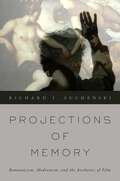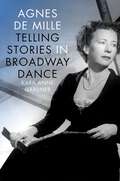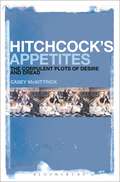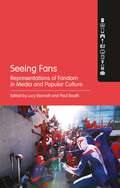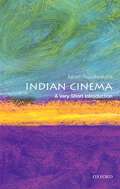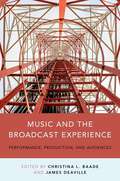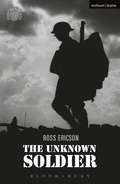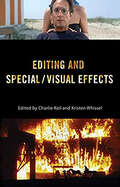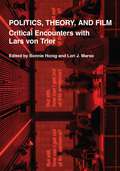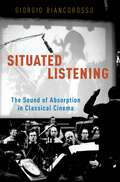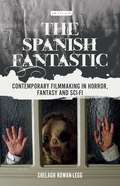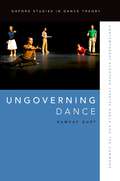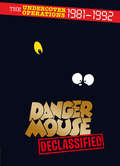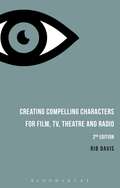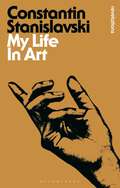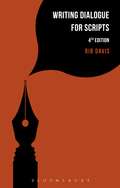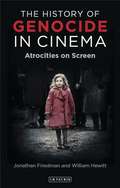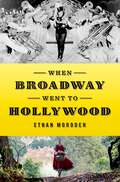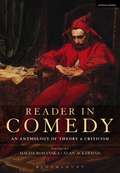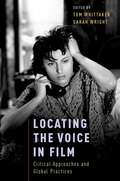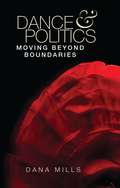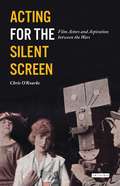- Table View
- List View
Projections of Memory: Romanticism, Modernism, and the Aesthetics of Film
by Richard I. SuchenskiProjections of Memory is an exploration of a body of innovative cinematic works that utilize their extraordinary scope to construct monuments to the imagination that promise profound transformations of vision, selfhood, and experience. This form of cinema acts as a nexus through which currents from the other arts can interpenetrate. By examining the strategies of these projects in relation to one another and to the larger historical forces that shape them--tracing the shifts and permutations of their forms and aspirations--Projections of Memory remaps film history around some of its most ambitious achievements and helps to clarify the stakes of cinema as a twentieth-century art form.
Eight Female Classical Ballet Variations
by Nina DanilovaFrom the graceful flutter of Princess Florine at Sleeping Beauty's wedding to the playful jetées in the first act of Giselle, the variation - or short solo work - is one of the key elements of classical ballet. Arguing that true artistry requires in-depth knowledge, author Nina Danilova has worked with students for many years to focus on performing individual variations with the greatest extent of technical proficiency and artistic sensitivity. Eight Female Classical Ballet Variations lays out eight variations in the ballerina's repertoire. Each chapter is divided into five sections: a piano reduction of the score; a contextual note covering the history of the ballet, the plot, and memorable dancers who have performed the role; and instructions for dancing the variation itself, illustrated step by step. Accompanied by a comprehensive companion website, Eight Female Classical Ballet Variations pairs Danilova's method of teaching students with her decades of pedagogical experience.
Agnes de Mille: Telling Stories in Broadway Dance (Broadway Legacies)
by Kara Anne GardnerThis book explores the Broadway legacy of choreographer Agnes de Mille, from the 1940s through the 1960s. Six musicals are discussed in depth - Oklahoma!, One Touch of Venus, Bloomer Girl, Carousel, Brigadoon, and Allegro. Oklahoma!, Carousel, and Brigadoon were de Mille's most influential and lucrative Broadway works. The other three shows exemplify aspects of her legacy that have not been fully examined, including the impact of her ideas on some of the composers with whom she worked; her ability to incorporate a previously conceived work into the context of a Broadway show; and her trailblazing foray into the role of choreographer/director. Each chapter emphasizes de Mille's unique contributions to the original productions. Several themes emerge in looking closely at de Mille's Broadway repertoire. Character development remained at the heart of her theatrical work work. She often took minor characters, represented with minimal or no dialogue, and fleshed out their stories. These stories added a layer of meaning that resulted in more complex productions. Sometimes, de Mille's stories were different from the stories her collaborators wanted to tell, which caused many conflicts. Because her unique ideas often got woven into the fabric of her musicals, de Mille saw her choreography as an authorship. She felt she should be given the same rights as the librettist and the composer. De Mille's work as an activist is an aspect of her legacy that has largely been overlooked. She contributed to revisions in dance copyright law and was a founding member of the Stage Directors and Choreographers Society, a theatrical union that protects the rights of directors and choreographers. Her contention that choreographers are authors who have their own stories to tell offers a new way of understanding the Broadway musical.
Hitchcock's Appetites: The Corpulent Plots of Desire and Dread
by Casey McKittrickIn Hitchcock's Appetites, Casey McKittrick offers the first book-length study of the relationship between Hitchcock's body size and his cinema. Whereas most critics and biographers of the great director are content to consign his large figure and larger appetite to colorful anecdotes of his private life, McKittrick argues that our understanding of Hitchcock's films, his creative process, and his artistic mind are incomplete without considering his lived experience as a fat man.Using archival research of his publicity, script collaboration, and personal communications with his producers, in tandem with close textual readings of his films, feminist critique, and theories of embodiment, Hitchcock's Appetites produces a new and compelling profile of Hitchcock's creative life, and a fuller, more nuanced account of his auteurism.
Seeing Fans: Representations of Fandom in Media and Popular Culture
by Paul Booth Lucy BennettSplit into four sections, Seeing Fans analyzes the representations of fans in the mass media through a diverse range of perspectives. This collection opens with a preface by noted actor and fan Orlando Jones (Sleepy Hollow), whose recent work on fandom (appearing with Henry Jenkins at Comic Con and speaking at the Fan Studies Network symposium) bridges the worlds of academia and the media industry. Section one focuses on the representations of fans in documentaries and news reports and includes an interview with Roger Nygard, director of Trekkies and Trekkies 2. The second section then examines fictional representations of fans through analyses of television and film, featuring interviews with Emily Perkins of Supernatural, Robert Burnett, director of the film Free Enterprise, and Luminosity, a fan who has been interviewed in the New York Magazine for her exemplary work in fandom. Section three explores cultural perspectives on fan representations, and includes an interview with Laurent Malaquais, director of Bronies: The Extremely Unexpected Adult Fans of My Little Pony. Lastly, the final section looks at global perspectives on the ways fans have been represented and finishes with an interview with Jeanie Finlay, director of the music documentary Sound it Out. The collection then closes with an afterword by fan studies scholar Professor Matt Hills.
Indian Cinema: A Very Short Introduction (Very Short Introductions)
by Ashish RajadhyakshaOne film out of every five made anywhere on earth comes from India. From its beginnings under colonial rule through to the heights of Bollywood , Indian Cinema has challenged social injustices such as caste, the oppression of Indian women, religious intolerance, rural poverty, and the pressures of life in the burgeoning cities. And yet, the Indian movie industry makes only about five percent of Hollywood's annual revenue. In this Very Short Introduction Ashish Rajadhyaksha delves into the political, social, and economic factors which, over time, have shaped Indian Cinema into a fascinating counterculture. Covering everything from silent cinema through to the digital era, Rajadhyaksha examines how the industry reflects the complexity and variety of Indian society through the dramatic changes of the 20th century, and into the beginnings of the 21st. ABOUT THE SERIES: The Very Short Introductions series from Oxford University Press contains hundreds of titles in almost every subject area. These pocket-sized books are the perfect way to get ahead in a new subject quickly. Our expert authors combine facts, analysis, perspective, new ideas, and enthusiasm to make interesting and challenging topics highly readable
Music and the Broadcast Experience: Performance, Production, and Audiences
Music and the Broadcast Experience explores the complex ways in which music and broadcasting have developed together throughout the twentieth and into the twenty-first centuries. It brings into dialogue researchers working in media and music studies; explores and develops crucial points of contact between studies of music in radio and music in television; and investigates the limits, persistence, and extensions of music broadcasting in the Internet era. The book presents a series of case studies that address key moments and concerns in music broadcasting, past and present, written by leading scholars in the field, who hail from both media and music studies. Unified by attentiveness both to musical sound and meaning and to broadcasting structures, practices, audiences, and discourses, the chapters in this collection address the following topics: the role of live orchestral concerts and opera in the early development of radio and their relation to ideologies of musical uplift; the relation between production culture, music, and television genre; the function of music in sponsored radio during the 1930s; the fortunes of musical celebrity and artistic ambition on television; questions of music format and political economy in the development of online radio; and the negotiation of space, community, and participation among audiences, online and offline, in the early twenty-first century. The collection's ultimate aim is to explore the usefulness and limitations of broadcasting as a concept for understanding music and its cultural role, both historically and today.
The Unknown Soldier (Modern Plays)
by Ross EricsonDon't, for God's sake, come back alive 'cause we don't want to see your ugly stumps and your ugly scars. We don't want to hear your midnight screams and tales of hell. We all got along nicely without you, thank you very much, and now you're back you remind us things we'd much rather forget. More convenient, ain't it? To have a dead hero. A dead hero don't have complaints. A dead hero don't even have a voice.Jack stayed on when the guns fells silent, to search the battlefields for the boys that could not go home - for the dead and the missing, for both enemy and friend. And amongst the rusty wire and unexploded bombs, Jack is looking for something - looking for someone. He has a promise to keep and debt to repay, and now there is this strange request from the generals.A story of comradeship, betrayal and of promises both broken and kept following the carnage of World War One from the acclaimed writer of Casualties, Ross Ericson. It received its world premiere at the Edinburgh Festival Fringe 2015 before embarking on a UK tour.
Editing and Special/Visual Effects: Behind the Silver Screen: A Modern History of Filmmaking
The expert contributors together trace how the arts of editingand effects have evolved in tandem, starting with the 'trick films'of the early silent era, which astounded audiences by splicingin or editing out key frames, all the way to today's cutting-edgeeffects technologies. Multiple filmmaking techniques are exploredthroughout, from classic Hollywood's rear projection and matteshots to the fast cuts and wall-to-wall CGI of the contemporaryblockbuster. The book introduces readers to the analog and digitaltools used in these crafts, showing the impact of changes in the filmindustry itself.
Politics, Theory, and Film: Critical Encounters with Lars von Trier
Lars von Trier's intense, disturbing, and sometimes funny films have led many to condemn him as misogynist or misanthropic. The same films inspire this collection's reflections on how our fears and desires regarding gender, power, race, finitude, family, and fate often thwart -- and sometimes feed -- our best democratic aspirations. The essays in this volume attend to von Trier's role as provocateur, as well as to his films' techniques, topics, and storytelling. Where others accuse von Trier of being clichéd, the editors argue that he intensifies the "clichés of our times" in ways that direct our political energies towards apprehending and repairing a shattered world. The book is certainly for von Trier lovers and haters but, at the same time, political, critical, and feminist theorists entirely unfamiliar with von Trier's films will find this volume's essays of interest. Most of the contributors tarry with von Trier to develop new readings of major thinkers and writers, including Agamben, Bataille, Beauvoir, Benjamin, Deleuze, Euripides, Freud, Kierkegaard, Ranciére, Nietzsche, Winnicott, and many more. Von Trier is both central and irrelevant to much of this work. Writing from the fields of classics, literature, gender studies, philosophy, film and political theory, the authors stage an interdisciplinary intervention in film studies.
Situated Listening: The Sound of Absorption in Classical Cinema
by Giorgio BiancorossoScreenwriters and film directors have long been fascinated by the challenges of representing the listening experience on screen. While music has played a central role in film narrative since the conception of moving pictures, the representation of music listening has remained a special occurrence. In Situated Listening: The Sound of Absorption in Classical Cinema, author Giorgio Biancorosso argues for a redefinition of the music listener as represented in film. Rather than construct the listener as a reverential concertgoer, music analyst, or gallery dweller, this book instead shows how films offer a new way of thinking about listening as distributed experience, an activity made public and shareable across vast cultural spaces rather than an insular motion. It shows how cinema functions as not only a reservoir of established modes of listening, but also an agent in the development of new listening practices. As Biancorosso argues, many films have perpetuated a long-existing paradox of music as a means of silencing. Consider an aggressive score overlaying battle scenes or a romantic scene conveying unspoken intimacy. In the place of conversational exchange exists a veil of sound in the form of music, and Situated Listening explains why this function influences both the course of interpretation and empathy experienced by film spectators. By focusing on cinematic, physical, and emotional scenery surrounding a character, viewers can recognize aspects of their own lives, developing a deeper empathy for each fictional character through real and shared listening practices.
The Spanish Fantastic: Contemporary Filmmaking in Horror, Fantasy and Sci-fi
by Shelagh Rowan-LeggIn recent decades, the Spanish 'fantastic' has been at the forefront of genre filmmaking. Films such as The Day of the Beast, the Rec trilogy, The Orphanage and Timecrimes have received widespread attention and popularity, arguably rescuing Spanish cinema from its semi-invisibility during the creativity-crushing Franco years. By turns daring, evocative, outrageous, and intense, this new cinema has given voice to a generation, both beholden to and yet breaking away from their historical and cultural roots. Beginning in the 1990s, films from directors such as Alex de la Iglesia, Alejandro Amenabar, and Jaume Balaguero reinvigorated Spanish cinema in the horror, science fiction and fantasy veins as their work proliferated and took centre stage at international festivals such as Sitges, Fantasia International Film Festival and Fantastic Fest. Through an examination of key films and filmmakers, Shelagh Rowan-Legg here investigates the rise of this unique new wave of genre films from Spain, and how they have recycled, reshaped and renewed the stunning visual tropes, wild narratives and imaginative other worlds inherent to an increasingly influential cinematic field.Its emergence is part of a new trend of postnational cinema, led by the fantastic, which approaches the national boundaries of cinema with an exciting sense of fluidity.
Ungoverning Dance: Contemporary European Theatre Dance and the Commons (Oxford Studies in Dance Theory)
by Ramsay BurtUngoverning Dance examines the work of progressive contemporary dance artists in continental Europe from the mid 1990s to 2015. Placing this within the context of neoliberalism and austerity, the book argues that these artists have developed an ethico-aesthetic approach that uses dance practices as sites of resistance against dominant ideologies, and that their works attest to the persistence of alternative ways of thinking and living. In response to the way that the radical values informing their work are continually under attack from neoliberalism, these artists recognise that they in effect share common pool resources. Thus, while contemporary dance has been turned into a market, they nevertheless value the extent to which it functions as a commons. Work that does this, it argues, ungoverns dance. The book offers close readings of works from the 1990s and 2000s by two generations of European-based dance artists: that of Jérôme Bel, Jonathan Burrows, La Ribot, and Xavier Le Roy who began showing work in the 1990s; and that of artists who emerged in the 2000s including Fabián Barba, Faustin Linyekula, Ivana Müller, and Nikolina Pristas. Topics examined include dance and precarious life, choreographing friendship, re-performance, the virtual in dance, and a dancer's experience of the Egyptian revolution. Ungoverning Dance proposes new ways of understanding recent contemporary European dance works by making connections with their social, political, and theoretical contexts.
Danger Mouse: Declassified
by Sir Arthur Stuyvesant Quinn-Flossy IV (Bart.)Crumbs! Danger Mouse’s most sensitive, scintillating and secret operations have been revealed for the first time in this top-secret dossier. Kept under lock and key at MI5 (or is it MI6? One of the Mouse Intelligence agencies, anyway...) for over 35 years, finally discover how DM saves London, the world and, most importantly, Penfold in fantastically absurd adventures. Be shocked and surprised, amazed and astounded by stories including the audacious theft of a chunk of ozone; the planned sabotage of the Royal wedding; and a sinister attempt by Jeremy Beagle to take over the airwaves.Cor blimey!
Creating Compelling Characters for Film, TV, Theatre and Radio
by Rib DavisStrong characters – characters we love and hate, those we despair for at their low moments and egg on to their triumphs – are the foundation of any successful script. Written by award-winning writer Rib Davis and now fully updated for its second edition, Creating Compelling Characters for Film, TV, Theatre and Radio is an authoritative practical guide to developing characters for professional and aspiring writers alike.As well as exploring character motivation, the interplay between character and plot, comic characters, heroes and villains, the new edition also includes a more in-depth look at character psychology, writing ensemble and multi-narrative dramas and the balance between character development and character revelation. The book also includes a wide range of contemporary examples from scripts ranging from films such as The Wolf of Wall Street and The Grand Budapest Hotel, award-winning plays such as Jerusalem and acclaimed TV shows such as Game of Thrones and True Detective.
My Life In Art (Bloomsbury Revelations)
by Constantin StanislavskiNo one has had a greater influence on acting as we know it than Stanislavski. His 'method' - or interpretations of it - has become the central force determining almost every performance we see on stage or screen. In My Life in Art Stanislavski recalls his theatrical career, from his early experiences in Rubinstein's Russian Musical Society to his final triumphs with Chekhov at the Moscow Art Theatre. His vivid accounts of his own most famous productions including 'The Seagul' and 'Uncle Vanya' are interspersed with anecdotes of the famous - of Kommisarjevksy, Tolstoy, Gorky, and of the Moscow visit of Isadora Duncan and Gordon Craig.
Writing Dialogue for Scripts (Writing Handbooks)
by Rib DavisA good story can easily be ruined by bad dialogue. Now in its 4th edition, Rib Davis's bestselling Writing Dialogue for Scripts provides expert insight into how dialogue works, what to look out for in everyday speech and how to use dialogue effectively in scripts. Examining practical examples from film, TV, theatre and radio, this book will help aspiring and professional writers alike perfect their skills. The 4th edition of Writing Dialogue for Scripts includes: a look at recent films, such as American Hustle and Blue Jasmine; TV shows such as Mad Men and Peaky Blinders; and the award winning play, Ruined. Extended material on use of narration within scripts (for example in Peep Show) and dialogue in verbatim scripts (Alecky Blythe's London Road) also features.
Costume, Makeup and Hair
Costume, Makeup and Hair reveals how these three crafts have continually adapted to new conditions, making the transitions from stage to screen, from monochrome to colour, and from analog to digital. It considers them in relation to a wide range of film genres, from sci-fi spectacles to period dramas, as well as examining how they have been active participants in the marketplace for fashion and beauty products. Drawing on rare archival materials and lavish colour illustrations, the expert contributors provide readers in film and fashion with groundbreaking film history and an appreciation of cinematic costume, makeup and hairstyling as distinct art forms.
The History of Genocide in Cinema: Atrocities on Screen (International Library of Twentieth Century History)
by William Hewitt Jonathan FriedmanThe organization 'Genocide Watch' estimates that 100 million civilians around the globe have lost their lives as a result of genocide in only the past sixty years. Over the same period, the visual arts in the form of documentary footage has aided international efforts to document genocide and prosecute those responsible, but this book argues that fictional representation occupies an equally important and problematic place in the process of shaping minds on the subject. Edited by two of the leading experts in the field, The History of Genocide in Cinema analyzes fictional and semi-fictional portrayals of genocide, focusing on, amongst others, the repression of indigenous populations in Australia, the genocide of Native Americans in the 19th century, the Herero genocide, Armenia, the Holodomor (Stalin's policy of starvation in Ukraine), the Nazi Holocaust, Nanking and Darfur. Comprehensive and unique in its focus on fiction films, as opposed to documentaries, The History of Genocide in Cinema is an essential resource for students and researchers in the fields of cultural history, holocaust studies and the history of film.
When Broadway Went to Hollywood
by Ethan MorddenWhen films like The Jazz Singer started to integrate synchronized music, in the late 1920s many ambitious songwriting pioneers of the Great White Way - George and Ira Gershwin, Cole Porter, Richard Rodgers, and Lorenz Hart, among many others - were enticed westward by Hollywood studios' promises of national exposure and top dollar success. But what happened when writers native to the business of Broadway ran into the very different business of Hollywood? Their movies had their producer despots, their stacking of writing teams on a single project, their use of five or six songs per story where Broadway fit in a dozen, and it seemed as if everyone in Hollywood was uncomfortable with characters bursting into song on the street, in your living room, or in "a cottage small by a waterfall." Did the movies give theater writers a chance to expand their art, or did mass marketing ruin the musical's quintessential charm? Is it possible to trace the history of the musical through both stage and screen manifestations, or did Broadway and Hollywood give rise to two wholly irreconcilable art forms? And, finally, did any New York writer or writing team create a film musical as enthralling and timeless as their work for the stage? In When Broadway Went to Hollywood, writer and celebrated steward of musical theatre Ethan Mordden directs his unmistakable wit and whimsy to these challenging questions and more, charting the volatile and galvanizing influence of Broadway on Hollywood (and vice versa) throughout the twentieth century. Along the way, he takes us behind the scenes of the great Hollywood musicals you've seen and loved (The Wizard of Oz, Gigi, The Sound of Music, Chicago, West Side Story, The Music Man, Grease) as well as some of the outrageous flops you probably haven't. The first book to tell the story of how Broadway affected the Hollywood musical, When Broadway Goes to Hollywood is sure to thrill theatre buffs and movie lovers alike.
Reader in Comedy: An Anthology of Theory and Criticism
by Magda Romanska Alan AckermanThis unique anthology presents a selection of over seventy of the most important historical essays on comedy, ranging from antiquity to the present, divided into historical periods and arranged chronologically. Across its span it traces the development of comic theory, highlighting the relationships between comedy, politics, economics, philosophy, religion, and other arts and genres. Students of literature and theatre will find this collection an invaluable and accessible guide to writing from Plato and Aristotle through to the twenty-first century, in which special attention has been paid to writings since the start of the twentieth century.Reader in Comedy is arranged in five sections, each featuring an introduction providing concise and informed historical and theoretical frameworks for the texts from the period:* Antiquity and the Middle Ages* The Renaissance* Restoration to Romanticism* The Industrial Age* The Twentieth and Early Twenty-First CenturiesAmong the many authors included are: Plato, Aristotle, Horace, Donatus, Dante Alighieri, Erasmus, Trissino, Sir Thomas Elyot, Thomas Wilson, Sir Philip Sidney, Ben Jonson, Battista Guarini, Molière, William Congreve, John Dryden, Henry Fielding, Samuel Johnson, Oliver Goldsmith, Jean Paul Richter, William Hazlitt, Charles Lamb, Søren Kierkegaard, Charles Baudelaire, Bernard Shaw, Mark Twain, Henri Bergson, Constance Rourke, Northrop Frye, Jacques Derrida, Mikhail Bakhtin, Georges Bataille, Simon Critchley and Michael North.As the selection demonstrates, from Plato and Aristotle to Henri Bergson and Sigmund Freud, comedy has attracted the attention of serious thinkers. Bringing together diverse theories of comedy from across the ages, the Reader reveals that, far from being peripheral, comedy speaks to the most pragmatic aspects of human life.
Locating the Voice in Film: Critical Approaches and Global Practices
Where is the place of the voice in film? Where others have focused on Hollywood film, this volume aims to extend the field to other cinemas from around the world, encompassing Latin America, Asia and Africa amongst others. Traditional theoretical accounts, based on classical narrative cinema, examine the importance of the voice in terms of a desired perfect match between visuals and sonic effects. But, as the chapters of this volume illustrate, what is normative in one film industry may not apply in another. The widespread practices of dubbing, postsynch sound and "playback singing" in some countries, for instance, provide an alternative means of understanding the location of the voice in the soundtrack. Through seventeen original chapters, this volume situates the voice in film across a range of diverse national, transnational and cultural contexts, presenting readings which challenge traditional readings of the voice in film in exciting new ways. By taking a comparative view, this volume posits that the voice may be best understood as a mobile object, one whose trajectory follows a broader network of global flows. The various chapters explore the cultural transformations the voice undergoes as it moves from one industry to another. In doing so, the volume addresses sound practices which have been long been neglected, such as dubbing and non-synch sound, as well the ways in which sound technologies have shaped nationally specific styles of vocal performance. In addressing the place of the voice in film, the book intends to nuance existing theoretical writing on the voice while applying these critical insights in a global context.
Dance and politics: Moving beyond boundaries
by Dana MillsThis book examines the political power of dance, particularly its transgressive potential. Focusing on readings of dance pioneers Isadora Duncan and Martha Graham, Gumboots dancers in the gold mines of South Africa, the One Billion Rising movement, dabke in Palestine and dance as a protest against human rights abuse in Israel, it explores moments in which the form succeeds in transgressing politics as articulated in words. Close readings and critical analysis grounded in radical democratic theory combine to show how reading political dance as 'interruption' can unsettle conceptions of both politics and dance.
Acting for the Silent Screen: Film Actors and Aspiration between the Wars (Cinema and Society)
by Chris O'RourkeA young man leaves his home to look for work in the cinema industry and disappears into the anonymity of showbiz rebuffals. A shop girl wins a newspaper competition and is transformed overnight into a transatlantic star. An aristocrat swaps high society for the film studio when she 'consents' to act in a series of films, thus legitimising acting for what some might have considered a 'low' art form. Stories like these were the stuff of newspaper headlines in 1920s Britain and reflected a national 'craze' for the cinema. They also demonstrated radical changes in attitudes and values within British society in the wake of World War I.
Languid Bodies, Grounded Stances: The Curving Pathway of Neoclassical Odissi Dance (Dance and Performance Studies #9)
by Nandini SikandWidely believed to be the oldest Indian dance tradition, odissi has transformed over the centuries from a sacred temple ritual to a transnational genre performed—and consumed—throughout the world. Building on ethnographic research in multiple locations, this book charts the evolution of odissi dance and reveals the richness, rigor, and complexity of the form as it is practiced today. As author and dancer-choreographer Nandini Sikand shows, the story of odissi is ultimately a story of postcolonial India, one in which identity, nationalism, tradition, and neoliberal politics dramatically come together.
